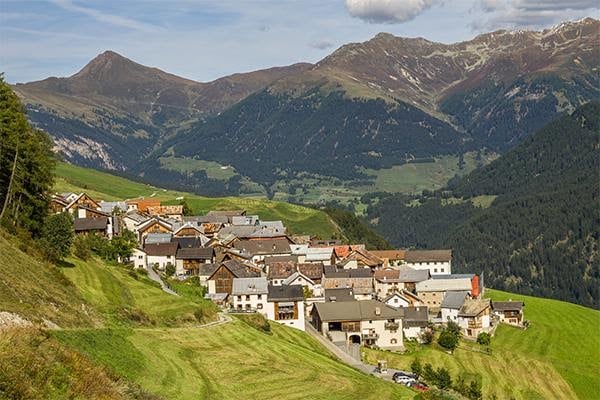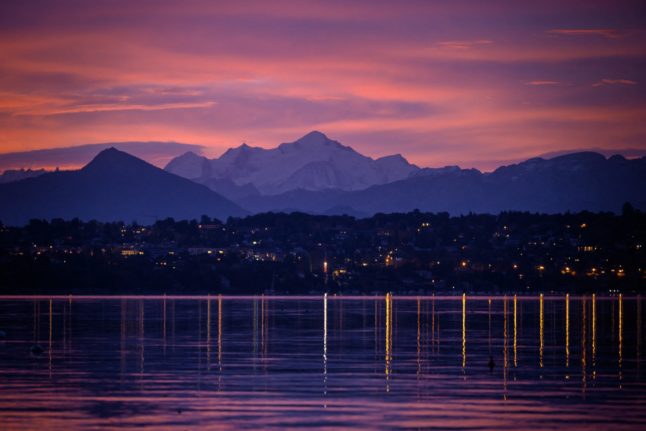The popular swiss contest “Das schönste Dorf der Schweiz” organised by the Ringier media group, every year crowns a ‘best village’ based on a public vote. But if the whole country knows about it then where’s the fun in that?
The Local asked the folks over at the association “Les plus beaux Villages de Suisse” (The most beautiful Villages in Switzerland) to come up with a list they consider to be the crème de la crème of Switzerland’s hidden treasures.
Without further ado, here are their picks. How many have you been to?
Valangin (NE)
Valangin is a medieval village with just 500 inhabitants. It’s position where the road narrows between Neuchâtel and La Chaux-de-Fonds is a key ingredient of its rich history.
Enjoy its picturesque setting and its relaxed atmosphere surrounded by nature and dominated by its castle which houses a very interesting museum.
Must see: A visit to the local castle, a medieval tower surrounded by ramparts
Tschlin (GR)
Tschlin, in the lower Engadine, is a pretty village located on a sunny terrace from where the view sweeps over the Italian, Austrian and Swiss Alps.
The old town is full of Engadin-style houses, narrow streets and flower-covered squares. In summer, when it’s hot, the local inhabitants cool off in the public fountains scattered throughout the village.
Must see: The magnificent late-gothic church of St. John the Baptist
Cabbio – Muggio (TI)
In the green Muggio Valley, in Canton Ticino, there are two authentic small villages marked by a common history: Cabbio and Muggio. In the first village there are magnificent and unique public fountains.
In Muggio, on the other hand, the houses built in local stone are reminiscent of distant times and the view of the terraces opposite is evocative of faraway exotic villages.
Must see: The Bruzella mill, still in operation, where one of the best polenta flour in Switzerland is produced.
Luthern (LU)
Not far from the chaotic Lucerne there is a quiet, little-known valley: the Luthertal. The main centre of this valley is the village of Luthern: a compact agglomeration of beautiful Lucerne houses and wooden farms scattered across the meadows.
As you walk through the streets of the village, the bellowing of the cows will keep you company and you will feel as if you are meeting Heidi at any moment.
Must see: The view of the village from the many surrounding paths. Not to be missed is the hike on the Napf.
Simplon Dorf (VS)
The Simplon Pass is one of the main passes connecting the Canton of Valais in Switzerland to Northern Italy. Few, however, are aware that a magnificent village is hidden nearby: Simplon Dorf.
This village echoes the Italian style in its architecture and its main square. This village is home to one of the oldest bakeries in Switzerland.
Must see: In the surroundings of the village are scattered ancient chapels which are worth a visit.
Eglisau (ZH)
Nestled along the Rhine River, just 20 minutes from Zurich, Eglisau is a quiet and charming village. Behind the row of magnificent houses rise several hills where vines are carefully cultivated by local families.
The wine produced here will impress even the most refined palates for its exquisiteness!
Must see: The Untergass is the main street of the village where there are the most beautiful corners of the village.
Lichtensteig (SG)
In the canton of St. Gallen, 600 metres above sea level, stands the semi-circle village of Lichtensteig founded around 1200 by the Counts of Toggenburg on a rock spur. In the alleyways, over a dozen shops, restaurants and cafés invite you to stroll and snoop around.
During events such as jazz days or the Christmas market, the old town does not become a backdrop, but remains a central part of the events.
Must see: The historical centre of the village with the church of St. Gallen.
Grandvillard (FR)
Grandvillard in Canton Fribourg has its origins as far back as Roman times and has preserved the traces of a strong past activity: granaries, mills, beaters, tanneries.
Just 10 minutes away from the much more famous Gruyères, this village has kept its authenticity intact. The main local product is the delicious cheese, considered by many to be one of the finest and tastiest.
Must see: At the edge of the forest, the house of Pierre de la Tinaz, cheese and banneret trader, still breathes the soul of this village.
Romainmôtier (VD)
Along the historic via Francigena, which connected Rome to Canterbury, we find one of the oldest abbeys in Switzerland that will leave you speechless.
The village is one of the hidden pearls of Canton Vaud. In addition to the magnificent abbey, it is also worth stopping to admire the other beauties such as Lieutenant Ballival’s house or the clock tower.
Must see: Of course the abbey, both outside and inside where frescoes from the 14th century are preserved.
Triesenberg (FL)
What’s a non-swiss village doing on this list? Triesenberg is in fact located in the Principality of Liechtenstein, a small independent state but with strong connection to Switzerland, having in common not only the language but also the currency, traditions and much more.
That’s why in 2019 it joined the swiss association of most beautiful villages. Triesenberg was founded by the Walser community on a panoramic terrace overlooking the Rhine valley.
Must see: The municipality has several beautiful hamlets: Masescha with its three-storey church, Steg with an idyllic alpine lake and Malbun with its state-of-the-art skiing facilities.
All of these villages and many more feature in the Les plus beaux Villages de Suisse free app available in english for iOS and Android.
All photos courtesy of Les plus beaux Villages de Suisse .



 Please whitelist us to continue reading.
Please whitelist us to continue reading.
Member comments